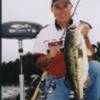FISHING REPORTS/BASS: GRASS STUDIES 101: Patterns continue to be multiple and varied but anglers have been successfully fishing along the edge of grass lines which are away from the bank. I am going to try to explain in more detail about what we mean when we talk about the grass line since I get numerous questions about this subject. We are not talking about grass you see growing along the shoreline but submerge grass (below surface) such as hydrilla, coontail and milfoil grasses.
Knowing the exact location of the edge of off-shore grass lines is vital to fish this pattern successfully. These grasses can be located with your electronics as well as with a depth-seeking lure such as a crankbait, worm rig or a combination of all. Also, a good set of polarized shades will often-time help if grass is not far below surface allowing the angler to actually see the grass-line. Many times bass will relate to the edge of this grass line and will hold there for cover as well as for bait-fish.
On many parts of Toledo this edge/wall of grass is between 6 to 12 feet. Generally speaking, the more north you go on the lake, the shallower the grass line whereas the deeper grass lines are generally on the south end. For example, currently there are some areas in Six Mile and Housen where the wall of grass is around 12 to 14 feet where as in the 1215/Patroon area the wall/edge of grass is 4 to 8 feet. The main factor here is water clarity with grass growing deeper in clearer water.
Next year conditions could be different as every year the submerged grass situation usually changes. The unique thing about the edge of submerged grass on Toledo is that there are fish there 12 months out of the year. They normally will react differently to lures, depending on the season, and will position themselves over/in/around the grass in various manners, depending on the weather, but they will stay near the grass.
This is where experience comes in when fishing this type structures as the angler must learn bass behavior. At times bass will hold/suspend off the grass a ways, while other times they will bury in the vegetation. The challenge is to figure where the bass are holding and choose the proper lure/presentation to get them to bite. The main thing is to learn to locate the grass line and begin to target a lot of your efforts there.
If you are just going down a bank casting to the shoreline, most of the bass are either under your boat or behind you. Sure, there are times when bass are on the bank but more often they are not. Of course, all of the bass in the lake will not be on this grass pattern but there will always as in ALWAYS be bass on Toledo's submerged grass.
To give a brief current report, anglers are using spinnerbaits, lipless crankbaits(Frenzy Rattl'rs/Rat-L-Traps) , mid-diving crankbaits (Deep Little Ns), Stanley Wedge spinnerbaits, Texas Rigged Berkley Power Lizards as well as jig n pigs along the edge of grass all over the lake. The water is cold so work these slowly. A deep pattern is also producing in 15-25 feet with deep diving DD22s, Carolina rigs, and football jigs (Berkley Gripper and Stanley Bug-eyed). Even deeper patterns in 25 to 40 feet is a drop-shot and jigging spoon.


